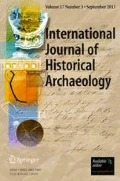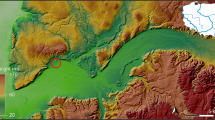Abstract
Archaeological survey in the Forêt domaniale des Andaines has recorded nearly 900 discrete earthwork bunkers, building foundations, trenches, and other features associated with WW2 German fuel, munitions and logistics depots. Documentary evidence establishes these depots were administered from Bagnoles-de-l’Orne and were a key component of the Seventh Army logistics network before and during the Normandy Campaign of June-August 1944. Post-war survival of features has been remarkably good in this forested setting and it is argued that this likely constitutes one of the best-preserved and most extensive examples of a non-hardened WW2 archaeological landscape yet documented in Western Europe.


















Similar content being viewed by others
References
Allcorn, W. (2003). The Maginot Line 1928–45, Osprey, Oxford.
Balicki, J. (2011). Watch-fires of a hundred circling camps: Theoretical and practical approaches to investigating Civil War campsites. In Geier, C. R., Babits, L. E., Scott, D. D., and Orr, D. G. (eds.), Historical archaeology of military sites: Method and topic, Texas A&M University Press, College Station, pp. 57–74.
Bleed, P., and Scott, D. D. (2011). Contexts for conflict: Conceptual tools for interpreting archaeological reflections of warfare. Journal of Conflict Archaeology 6: 42–64.
Carman, J. (2005). Battlefields as cultural resources. Post-Medieval Archaeology 39: 215–223.
Carr, G. (2010). The archaeology of occupation, 1940–2009: A case study from the Channel Islands. Antiquity 84: 161–174.
Carr, G. (2012). Occupation heritage, commemoration and memory in Guernsey and Jersey. History and Memory 24: 87–117.
Carr, G. (2014). Legacies of occupation: Archaeology, heritage and memory in the Channel Islands, Springer, New York.
Carr, G., and Jasinski, M. E. (2013). Sites of memory, sites of oblivion: The archaeology of twentieth century conflicts in Europe. In Bassanelli, M., and Postiglione, G. (eds.), Re-enacting the past: Museography for conflict heritage, LetteraVentidue, Siracusa, pp. 36–55.
Coad, J. (2005). Warfare and defence: what next? Post-Medieval Archaeology 39: 224–32.
Crutchley, S. (2009). Ancient and modern: combining different remote sensing techniques to interpret historic landscapes. Journal of Cultural Heritage 10S: e65–e71.
Crutchley, S., Small, F., and Bowden, M. (2009). Savernake Forest: A report for the National Mapping Programme, English Heritage, Portsmouth.
Demuth, V. (2009). Those who survived the battlefields: archaeological investigations in a prisoner of war camp near Quedlinburg (Harz/Germany) from the First World War. Journal of Conflict Archaeology 5: 163–181.
Dobinson, C. (2001). AA command: Britain’s anti-aircraft defences of World War II, Methuen, London.
Dobinson, C., Lake, J., and Schofield, A. J. (1997). Monuments of War: defining England’s 20th-century defence heritage. Antiquity 71: 288–99.
Forbes, N., Page, R., and Pérez, G. (eds.) (2009). Europe’s deadly century: Perspectives on 20th century conflict heritage, English Heritage, Swindon.
Francis, P. (1997). United States naval amphibious supply base Exeter, Airfield Research, Exeter.
Geier, C. R., Babits, L. E., Scott, D. D., and Orr, D. G. (eds.) (2011). Historical archaeology of military sites: Method and topics, Texas A&M University Press, College Station.
Glass, E. (2012). “Hitler loves Musso”, and other civilian wartime sentiments: The archaeology of Second World War air-raid shelters and their graffiti. In Saunders, N. J. (ed.), Beyond the dead horizon: Studies in modern conflict archaeology, Oxbow, Oxford, pp. 130–145.
Gooderson, I. (1998). Air Power at the Battlefront: Allied Close Air Support in Europe 1943–1945, Frank Cass, London.
Hairie, A. (2007). Camps et Depots des Andaines Coloniaux, Requis et Requises ou STO 1940–1944. Caen.
Harrison, R., and Schofield, J. (2010). After modernity: Archaeological approaches to the contemporary past, Oxford University Press, Oxford.
Hart, R. A. (1996). Feeding Mars: the role of logistics in the German defeat in Normandy, 1944. War in History 3: 418–435.
Hart, R. A. (2001). Clash of Arms: How the Allies won in Normandy, Lynne Rienner, Boulder.
Herval, R. (1947). Bataille de normandie récits and témoins, Editions notre Temps, Paris.
Isby, D. C. (ed.) (2004). Fighting the Breakout: The German Army in Normandy from “Cobra” to the Falaise Gap, Greenhill, London.
Jasinski, M. E., Soleim, M. N., and Sem, L. (2012). “Painful heritage”: Cultural landscapes of the Second World War in Norway: A new approach. In Berge, R., Jasinski, M. E., and Sognnes, K. (eds.), N-TAG TEN. Proceedings of the 10th Nordic TAG Conference at Stiklestad, Norway 2009, British Archaeological Reports, Oxford, pp. 263–73.
Kaufmann, J. E., and Jurga, R. M. (2002). Fortress Europe: European fortifications of World War II, Da Capo, Cambridge.
Laroze, A. (2004). Chemins oublies Du bocage, Septembre 1939-aout 1944, Andre Laroze, Saint-Sever.
Lynn, J. A. (ed.) (1993). Feeding Mars: Logistics in Western Warfare from the Middle Ages to the Present, Westview, Boulder.
Mallmann Showell, J. P. (2002). Hitler’s U-boat Bases, US Naval Institute Press, Annapolis.
Mayo, L. (1968). The Ordnance Department: On beachhead and battlefront, Center of Military History, Washington.
Moshenska, G. (2009). Resonant materiality and violent remembering: archaeology, memory and bombing. International Journal of Heritage Studies 15: 44–56.
Moshenska, G. (2013). The Archaeology of the Second World War: Uncovering Britain’s wartime heritage, Pen and Sword Archaeology, Barnsley.
Mytum, H., and Carr, G. (eds.) (2013). Prisoners of War: Archaeology, memory, and heritage of 19th- and 20th-century mass internment, Springer, London.
Neillands, R. (2002). The Battle of Normandy, 1944, Cassell, London.
Osborne, M. (2004). Defending Britain: Twentieth-century military structures in the landscape, Tempus, Stroud.
Osborne, M. (2008). Pillboxes of Britain and Ireland, Tempus, Stroud.
Passmore, D. G., and Harrison, S. (2008). Landscapes of the Battle of the Bulge: WW2 field fortifications in the Ardennes forests of Belgium. Journal of Conflict Archaeology 4: 87–107.
Passmore, D. G., Capps Tunwell, D., and Harrison, S. (2013). Landscapes of logistics: The archaeology and geography of WW2 German military supply depots in central Normandy, NW France. Journal of Conflict Archaeology 8: 165–192.
Passmore, D. G., Harrison, S., and Capps Tunwell, D. (2014). Second World War conflict archaeology in the forests of northwest Europe. Antiquity 88: 1275–1290.
Pearson, C. (2006). “The age of wood”: fuel and fighting in French forests, 1940–1944. Environmental History 11: 775–803.
Rass, C., and Lohmeier, J. (2011). Transformations: post-battle processes on the Hürtgenwald battlefield. Journal of Conflict Archaeology 6: 179–199.
Richardson, S. (2008). Destruction preserved: Second World War public air-raid shelters in Hamburg. In Rakoczy, L. (ed.), The archaeology of destruction, Cambridge Scholars, Newcastle upon Tyne, pp. 6–28.
Rottman, G. (2004). German field fortifications 1939–45, Osprey, Oxford.
Rougeyron, A. (1947). Agents d’Evasion: Imprimerie Alençonaise and André Rougeyron. Alençon.
Ruppenthal, R. G. (1995). Logistical support of the armies (US Army in World War II; the European Theatre of Operations, Vol I, Center of Military History, Washington.
Saunders, A. (1998). The Defence of Britain Project. In Schofield, J. (ed.), Monuments of War: The evaluation recording and management of twentieth-century military sites, English Heritage, London, pp. 7–9.
Schofield, J. (ed.) (1998). Monuments of War: The evaluation, recording and management of twentieth-century military sites, English Heritage, London.
Schofield, J. (2001). D-Day sites in England: An assessment. Antiquity 75: 77–83.
Schofield, J. (2002). Monuments and the memories of war: Motivations for preserving military sites in England. In Schofield, J., Johnson, W. G., and Beck, C. B. (eds.), Matériel culture: The archaeology of twentieth-century conflict, Routledge, London, pp. 143–158.
Schofield, J. (2004). Modern military matters: Studying and managing the twentieth century defence heritage in Britain: A discussion document, Council for British Archaeology, York.
Schofield, J., Evans, D., Foot, W., and Going, C. (2006). Thematic characterisation: Recording England’s army camps, 1858–2000. In Schofield, J., Klausmeier, A., and Purbrick, L. (eds.), Re-mapping the field: New approaches in conflict archaeology, Westkreuz-Verlag, Berlin, pp. 58–63.
Scott, D., and McFeaters, A. P. (2011). The archaeology of historic battlefields: a history and theoretical development in conflict archaeology. Journal of Archaeological Research 19: 103–132.
Searle, A. (2004). PLUTO: Pipe-Line Under The Ocean (2nd ed.). Shanklin Chine, Shanklin, Isle of Wight.
Seitsonen, O., and Herva, V.-P. (2011). Forgotten in the wilderness: WW2 German PoW camps in Finnish Lapland. In Moshenska, G., and Myers, A. (eds.), Archaeologies of Internment, Springer, New York, pp. 171–190.
Seitsonen, O., and Kunnas, L. (2009). Ahvola 1918: Archaeological reconnaissance of a Finnish Civil War battlefield. Journal of Conflict Archaeology 5: 57–80.
Short, N. (2004). Germany’s West Wall: The Siegfried line, Osprey, Oxford.
Thomas, R. J. C. (2003a). PoW camps: What survives and where. Conservation Bulletin 44: 18–21.
Thomas, R. J. C. (2003b). Prisoner of War camps (1939–1948). Project Report (Twentieth Century Military Recording Project), English Heritage, Swindon.
Toyofumi, O. (1994). The Atomic Bomb and Hiroshima, Liber, Tokyo.
Van Creveld, M. (2004). Supplying War: Logistics from Wallenstein to Patton (2nd ed), Cambridge University Press, Cambridge.
Williamson, G. (2003). U-Boat Bases and Bunkers, 1941–45, Osprey, Oxford.
Zaloga, S. J. (2007). The Atlantic Wall (1), Osprey, Oxford.
Acknowledgments
The authors are grateful for the help and support of Sue Rouillard (cartography, College of Life and Environmental Sciences, University of Exeter), Stéphane Robine (Archives Départementales de la Manche), Serge Raison (Raison Bois et Débits, Perrou), Christian Clement (Office National des Forêts) and Stephen Walton (Senior Curator, Documents & Sound Section, Imperial War Museum Duxford). We also thank the anonymous reviewers for their constructive comments on the original manuscript.
Author information
Authors and Affiliations
Corresponding author
Rights and permissions
About this article
Cite this article
Tunwell, D.C., Passmore, D.G. & Harrison, S. Landscape Archaeology of World War Two German Logistics Depots in the Forêt domaniale des Andaines, Normandy, France. Int J Histor Archaeol 19, 233–261 (2015). https://doi.org/10.1007/s10761-015-0287-4
Published:
Issue Date:
DOI: https://doi.org/10.1007/s10761-015-0287-4




